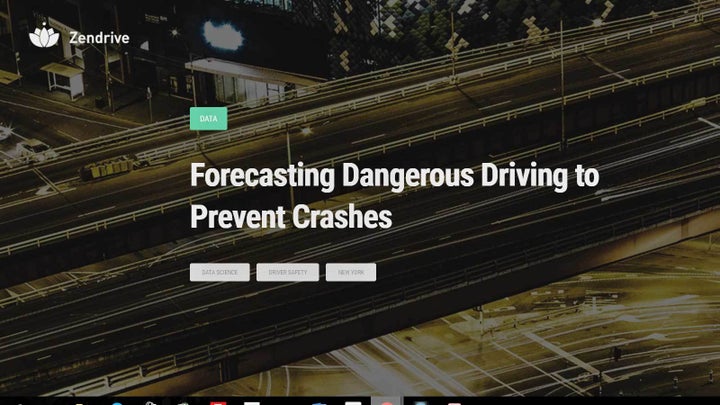
What if someone could figure out when, where and why traffic accidents occur and stop them from happening? Someone has.
Since the dawn of the automobile age, traffic accidents have been widely accepted as a tragic—but inevitable–side effect of modern life. Thanks to mobile phones, the problem is getting worse, not better. Traffic fatalities are creeping up again after decades of decline. More than 40,000 Americans were killed in car accidents in 2016, a 14 percent rise since 2014, according to the National Safety Council. That’s the biggest two-year surge in five decades.
Despite the severe toll, there has been a curious lack of urgency from the public and policymakers to do something about it. Officials attempting to address the problem—traffic engineers, police officers, policymakers, public health specialists–are working with information gathered after the fatalities and injuries have already occurred, often without reliable data, resources, or much political support.
A global movement called Vision Zero takes a radically different approach. Its premise is that traffic deaths and severe injuries are all preventable and sets the goal of eliminating both in a set time frame with clear, measurable strategies. Launched in Sweden two decades ago and widely adopted in many European cities, the Vision Zero approach has finally taken off in American cities.
Ten early adopter U.S. cities have joined the new Vision Zero Focus Cities program, launched by the Vision Zero Network. The ten cities are Austin, Boston. Chicago, Fort Lauderdale, Los Angles, New York, Portland, San Francisco, Seattle and Washington, D.C.
For a number of years, vehicle fleet managers, insurance companies and others have used a combination of On Board Diagnostic devices and GPS technology devices—mounted on each vehicle to pinpoint the location of their vehicles in near real time. The ODB enabled locator can also access vehicle diagnostic interface data, track speed and location, as well as detect hard braking, cornering, acceleration and capture pre and post-impact data.
What OCDs are not good at is analyzing driver behavior which, as it happens, is the most important factor of all in predicting and preventing crashes before they happen. Some 93% of collisions on the road are due to human error. One in four crashes is the result of phone use while driving.
In 2013, Jonathan Matus, who helped turn Google’s Android into the world’s dominant mobile software and later led the launch of Facebook’s mobile platform, teamed up with another Google engineer, Pankaj Risbood to found Zendrive, a tech company that uses sensors in smartphones to capture, analyze and then coach a driver on what they can do to be safer while behind the wheel.
Phones enabled with the Zendrive’s technology can relay data not only about when drivers are looking at their phones, but also how fast they’re driving at any given moment, or if they make hard turns at intersections. It detects collisions, aggressive driving, distracted driving, and more, including whether you’ve recently stopped at a pub.
In its short existence, Zendrive has collected and analyzed 15 billion miles of anonymized driving data. Progressive, a leader in insurance telematics, took nearly two decades to reach the same number of miles analyzed.
Largest Distracted Driver Survey
In April, Zendrive released the results of a three-month analysis of three-million anonymous U.S. drivers, making up 570-million trips and covering 5.6 billion miles. The key findings were both astounding and alarming:
- Drivers use their phones during 88 out of 100 trips
- Of these trips, the average phone use was 3-3.5 minutes
- Taking your eyes off the road for even 2-seconds increases your chances of a collision more than 20x
- At 55 mph, 2 seconds is enough time to travel the length of two basketball courts.
In an interview with Forbes, CEO Jonathan Matus said: “We were surprised to find that this risky behavior is so common. Almost 9 out of 10 car trips have some form of distracting phone use. This is truly an epidemic. It is more widespread than most people realize, and it parallels an overall trend: the number of crashes and fatalities on the road is growing at double-digit rate for the past few years. This is something we cannot ignore.”
Vision Zero, Zendrive and New York City
Zendrive is working closely with New York City in its Vision Zero goal which aims to eliminate traffic deaths and serious injuries in New York City by 2024. In partnership with New York University’s Tandon School of Engineering, Zendrive is using its 15-billion miles of data for predictive analytics to determine where collisions are likely to occur before they happen. (PDF)
NYU analyzed and mapped 33,450 risky driving events collected by Zendrive between July and December 2015 and 127,423 collisions reported by the NYPD between July 2012 and March 2017. During those four-plus years, over 1,200 people were killed in traffic on New York City streets.
By analyzing and mapping the data, NYU researchers found mappable correlations between driver behavior data and NYPD crash data. No real surprise here but they determined that the areas where people drive recklessly are the same areas where there are collisions. This means that it is possible—with the right mix of interventions–to stop reckless driving before it causes collisions, injuries and deaths.
They mapped the two datasets and compared the locations and density of the events in each category. Among the useful correlations:
- A 71-percent overlap between the locations of dangerous driving behaviors and traffic crashes around New York City.
- A 75-percent overlap between driver phone use and cell-phone-related crashes
- Just below 70-percent each for fast acceleration and aggressive driving/road rage collisions, along with hard braking and following too closely. \You can’t ignore the irony that a company founded by a guy who has done as much as anyone to make mobile phones ubiquitous is now using them to save lives, but Zendrive is one of those companies that arrived in the right place with the right product at exactly the right moment.
You can’t ignore the irony that a company founded by a guy who has done as much as anyone to make mobile phones ubiquitous is now using them to save lives, but Zendrive is one of those companies that arrived in the right place with the right product at exactly the right moment.
Although OBD data collected directly from the vehicle’s computer is marginally more accurate in measuring the vehicle’s performance, it is fairly oblivious to reckless human behavior by drivers and, in the end, that is the cause of most accidents and what Zendrive measures best.
Driven in large part by young bicyclists and runners who want to claim their share of the road from dangerous automobiles, public safety initiatives like Vision Zero are becoming more visible and more popular. As with campaigns to reduce drunk driving and initiatives to increase recycling, changing cultural attitudes and ensuring political and individual accountability can make a dramatic difference.
Zendrive provides real-time “big data” that allows city planners to focus on mitigating the most dangerous behaviors before they result in fatalities and injuries.
And, of course, there’s the company’s technology bloodlines. If Zendrive were a race horse, I’d put down a couple of bucks.
An earlier version of this article appeared on the technology expert blog Diginomica.
Image credit - via Zendrive
